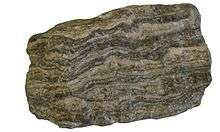Definify.com
Webster 1913 Edition
Foliation
Fo′li-a′tion
,Noun.
[Cf. F.
foliation
.] 1.
The process of forming into a leaf or leaves.
2.
The manner in which the young leaves are dispo[GREEK]ed within the bud.
The . . .
foliation
must be in relation to the stem. De Quincey.
3.
The act of beating a metal into a thin plate, leaf, foil, or lamina.
4.
The act of coating with an amalgam of tin foil and quicksilver, as in making looking-glasses.
5.
(Arch.)
The enrichment of an opening by means of foils, arranged in trefoils, quatrefoils, etc.; also, one of the ornaments. See
Tracery
. 6.
(Geol.)
The property, possessed by some crystalline rocks, of dividing into plates or slabs, which is due to the cleavage structure of one of the constituents, as mica or hornblende. It may sometimes include slaty structure or cleavage, though the latter is usually independent of any mineral constituent, and transverse to the bedding, it having been produced by pressure.
Webster 1828 Edition
Foliation
FOLIA'TION
,Noun.
1.
In botany, the leafing of plants; vernation; the disposition of the nascent leaves within the bud.2.
The act of beating a metal into a thin plate, leaf or foil3.
The act or operation of spreading foil over the back side of a mirror or looking-glass.Definition 2026
foliation
foliation
English

Foliation (property of being divided into layers) in a metamorphic rock (gneiss)
Noun
foliation (plural foliations)
- (botany) The process of forming into a leaf or leaves.
- (publishing) The process of forming into pages; pagination.
- (botany) The manner in which the young leaves are disposed within the bud.
- The act of beating a metal into a thin plate, leaf, foil, or lamina.
- The act of coating with an amalgam of tin foil and quicksilver, as in making looking-glasses.
- The enrichment of an opening by means of foils, arranged in trefoils, quatrefoils, etc.; also, one of the ornaments.
- 1907, Robert W[illiam] Chambers, “chapter I”, in The Younger Set (Project Gutenberg; EBook #14852), New York, N.Y.: A. L. Burt Company, published 1 February 2005 (Project Gutenberg version), OCLC 4241346:
- The house was a big elaborate limestone affair, evidently new. Winter sunshine sparkled on lace-hung casement, on glass marquise, and the burnished bronze foliations of grille and door.
-
- (geology) The property, possessed by some crystalline rocks, of being divided into plates or layers, due to the cleavage structure of one of the constituents, as mica or hornblende. It may sometimes include slaty structure or cleavage, though the latter is usually independent of any mineral constituent, and transverse to the bedding, it having been produced by pressure.
- 1993, Charles A. Baskerville, Fitzhugh T. Lee, Charles A. Ratté, Landslide Hazards in Vermont, U.S. Geological Survey Bulletin 2043, p.18:
- The dominant strike orientation of both bedding and foliation of Vermont bedrock is north or northeasterly.
- 1996, Eric C. Beam, Modeling Growth and Rotation of Porphyroblasts and Inclusion Trails, D.G. De Paor, Structural Geology and Personal Computers, p.249:
- They show that curved inclusion trails may form even with no coupling, as the porphyroblast overgrows foliation that is deflected around it.
- 2004, F. Martín-Hernández, C. M. Lüneburg, C. Aubourg, M. Jackson, Magnetic fabric: methods and applications - an introduction, Geological Society of London, Magnetic Fabric: Methods and Applications, p.3:
- In sedimentary rocks, the magnetic foliation results from a combination of depositional processes and diagenetic compaction.
- 1993, Charles A. Baskerville, Fitzhugh T. Lee, Charles A. Ratté, Landslide Hazards in Vermont, U.S. Geological Survey Bulletin 2043, p.18:
- (topology) A set of submanifolds of a given manifold, each of which is of lower dimension than it, but which, taken together, are coextensive with it.
- 1992, R. C. Penner, Combinatorics of Train Tracks, p.204:
- Historically, the formalism which first arose for the material we discuss is that of measured foliations in surfaces.
- 2003, Alberto Candel, Lawrence Conlon, Foliations, Vol.2, p.253:
- We will show that every closed 3-manifold has a foliation of codimension one. In 1952, G. Reeb published his construction of a foliation of the 3-sphere. About twelve years later, W. Lickorish [123] exhibited foliations of codimension one on every closed, orientable 3-manifold.
- 2004, Paweł Grzegorz Walczak, Dynamics Of Foliations, Groups And Pseudogroups, Monografie Matematyczne: Vol.64, New Series, p.6:
- The simplest example of a foliation is provided by a single submersion F : M → N, M and N being manifolds.
- 1992, R. C. Penner, Combinatorics of Train Tracks, p.204:
Synonyms
- (process of forming pages): pagination
- (growth and arrangement of leaves): vernation
Related terms
Translations
topology: a set of subspaces coextensive with a manifold
|